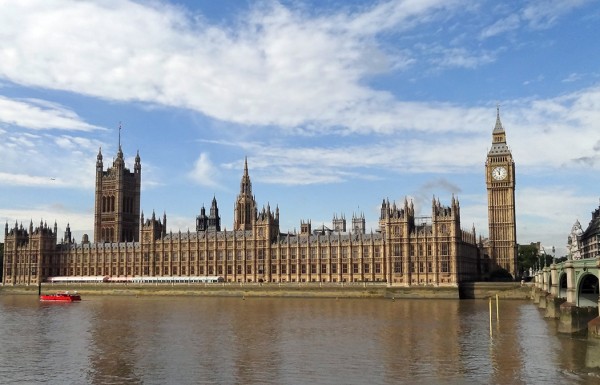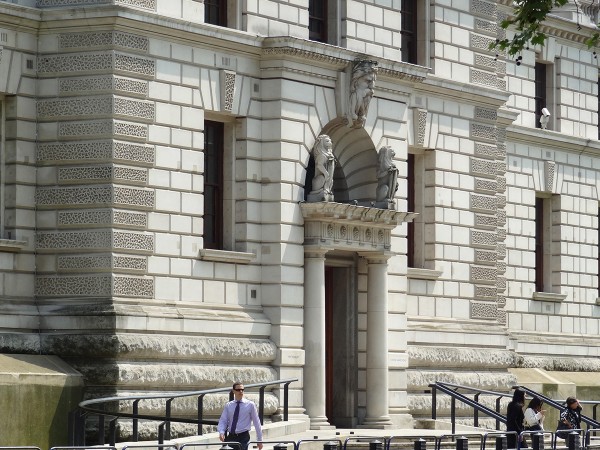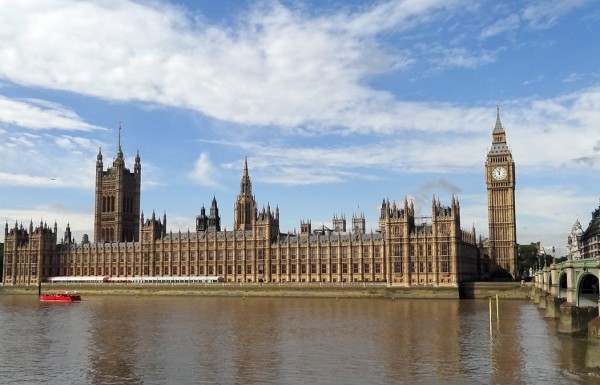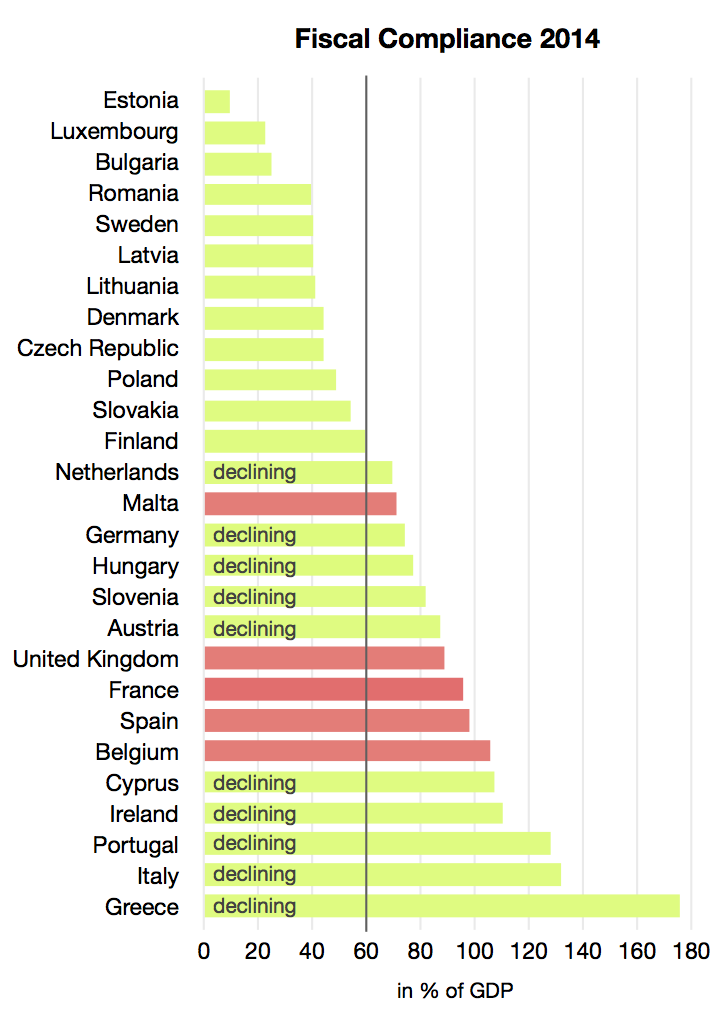 On election to office in May 2015, the UK’s Conservative government set new fiscal targets. These were set out in an updated Charter for Budget Responsibility. As Box 12.3 in Essentials of Economics (7th edition) states:
On election to office in May 2015, the UK’s Conservative government set new fiscal targets. These were set out in an updated Charter for Budget Responsibility. As Box 12.3 in Essentials of Economics (7th edition) states:
The new fiscal mandate set a target for achieving a surplus on public-sector net borrowing by the end of 2019/20. More controversially, government should then target a surplus in each subsequent year unless real GDP growth falls below 1 per cent … Meanwhile, the revised supplementary target for public-sector debt was for the net debt-to-GDP ratio to fall each year from 2015/16 to 2019/20.
What is more, the Charter requires the government to set a cap on welfare spending over a five-year period.  Such spending includes spending on pensions, tax credits, child benefit and unemployment benefit. In July 2015 the Chancellor set this cap at £115bn for 2016/17, a reduction of £12bn.
Such spending includes spending on pensions, tax credits, child benefit and unemployment benefit. In July 2015 the Chancellor set this cap at £115bn for 2016/17, a reduction of £12bn.
Whether or not such a tight fiscal target is desirable, the government has been missing the target. In November last year, the Chancellor had to backtrack on his plans to make substantial reductions in tax credits and as a result the welfare cap has been breached, as the following table from page 5 of the December 2015 House of Commons briefing paper shows.

Also, with the slowing of economic growth, the Chancellor has stated that he will miss the requirement for a fall in the net debt-to-GDP ratio unless further cuts in government spending are made, equivalent to 50p in every £100.
But, if the economy is slowing, is it right to cut government expenditure? In other words, should there be some discretion in fiscal policy to respond to economic circumstances? There are two issues here. The first is whether the resulting cut in aggregate demand will be detrimental to growth. The second is who will bear the cost of such cuts. Critics of the government claim that it will largely the poor who will lose if the cuts are made mainly from benefits.
The articles below examine the public finances, the difficulties George Osborne has been facing in sticking to his fiscal mandate and the options open to him.
Articles
Budget 2016: Osborne’s economic fitness regime BBC News, Andy Verity (14/3/16)
Budget 2016: George Osborne fuels speculation of nasty shocks The Guardian, Larry Elliott and Anushka Asthana (14/3/16)
Official publications
Charter for Budget Responsibility: Summer Budget 2015 update HM Treasury (July 2015)
OBR publications, including ‘Economic and fiscal outlook’ and ‘Fiscal sustainability report’ Office for Budget Responsibility
Questions
- Outline the main points of the Charter for Budget Responsibility (CBR).
- What are the arguments for sticking to fiscal rules, such as those in the CBR?
- What are the arguments for using discretion to adjust fiscal policy as economic circumstances change?
- Compare the Conservative government’s fiscal mandate with the newly announced approach to fiscal policy of the Labour opposition?
- How does the Labour Party’s new approach differ from the Golden Rule followed by Gordon Brown as Chancellor in the Labour government from 1997 to 2007?
- What factors will determine whether or not the government will return to meeting the rules set out in the Charter for Budget Responsibility?
 In his annual Mansion House speech to business leaders on 10 June 2015, George Osborne announced a new fiscal framework. This would require governments in ‘normal times’ to run a budget surplus. Details of the new framework would be spelt out in the extraordinary Budget, due on 8 July.
In his annual Mansion House speech to business leaders on 10 June 2015, George Osborne announced a new fiscal framework. This would require governments in ‘normal times’ to run a budget surplus. Details of the new framework would be spelt out in the extraordinary Budget, due on 8 July.
If by ‘normal times’ is meant years when the economy is growing, then this new fiscal rule would mean that in most years governments would be require to run a surplus. This would reduce general government debt.
And it would eventually reduce the debt from the forecast ratio of 89% of GDP for 2015 to the target of no more than 60% set for member states under the EU’s Stability and Growth Pact. Currently, many countries are in breach of this target, although the Pact permits countries to have a ratio above 60% provided it is falling towards 60% at an acceptable rate. The chart shows in pink those countries that were in breach in 2014. They include the UK.
 Sweden and Canada have similar rules to that proposed by George Osborne, and he sees them as having been more able to use expansionary fiscal policy in emergency times, such as in the aftermath of the financial crisis of 2007/8, without running excessive deficits.
Sweden and Canada have similar rules to that proposed by George Osborne, and he sees them as having been more able to use expansionary fiscal policy in emergency times, such as in the aftermath of the financial crisis of 2007/8, without running excessive deficits.
Critics have argued, however, that running a surplus whenever there is economic growth would dampen recovery if growth is sluggish. This makes the rule very different from merely requiring that, over the course of the business cycle, there is a budget balance. Under that rule, years of deficit are counterbalanced by years of surplus, making fiscal policy neutral over the cycle. With a requirement for a surplus in most years, however, fiscal policy would have a net dampening effect over the cycle. The chancellor hopes that this would be countered by increased demand in the private sector and from exports.
The rule is even more different from the Coalition government’s previous ‘fiscal mandate‘, which was for a ‘a forward-looking target to achieve cyclically-adjusted current balance by the end of the rolling, five-year forecast period’. The current budget excludes investment expenditure on items such as transport infrastructure, hospitals and schools. The fiscal mandate was very similar to the former Labour government’s ‘Golden rule’, which was to achieve a current budget balance over the course of the cycle.
 By excluding public-sector investment from the target, as was previously done, it can allow borrowing to continue for such investment, even when there is a substantial deficit. This, in turn, can help to increase aggregate supply by improving infrastructure and has less of a dampening effect on aggregate demand. A worry about the new rule is that it could lead to further erosion of public-sector investment, which can be seen as vital to long-term growth and development of the economy. Indeed, Sweden decided in March this year to abandon its surplus rule to allow government borrowing to fund investment.
By excluding public-sector investment from the target, as was previously done, it can allow borrowing to continue for such investment, even when there is a substantial deficit. This, in turn, can help to increase aggregate supply by improving infrastructure and has less of a dampening effect on aggregate demand. A worry about the new rule is that it could lead to further erosion of public-sector investment, which can be seen as vital to long-term growth and development of the economy. Indeed, Sweden decided in March this year to abandon its surplus rule to allow government borrowing to fund investment.
The podcasts and articles below consider the implications of the new rule for both aggregate demand and aggregate supply and whether adherence to the rule will help to increase or decrease economic growth over the longer term.
Video and audio podcasts
 George Osborne confirms budget surplus law Channel 4 News, Gary Gibbon (10/6/15)
George Osborne confirms budget surplus law Channel 4 News, Gary Gibbon (10/6/15)
 Osborne To Push Through Budget Surplus Rules Sky News (10/6/15)
Osborne To Push Through Budget Surplus Rules Sky News (10/6/15)
 OECD On Osborne’s Fiscal Plans Sky News, Catherine Mann (10/6/15)
OECD On Osborne’s Fiscal Plans Sky News, Catherine Mann (10/6/15)
 ‘Outright fiscal madness’ Osborne’s Mansion House Speech RT UK on YouTube, Harry Fear (11/6/15)
‘Outright fiscal madness’ Osborne’s Mansion House Speech RT UK on YouTube, Harry Fear (11/6/15)
 A “straightjacket” [sic] on future government spending? BBC Today Programme, Robert Peston; Nigel Lawson (11/6/15)
A “straightjacket” [sic] on future government spending? BBC Today Programme, Robert Peston; Nigel Lawson (11/6/15)
 Thursday’s business with Simon Jack BBC Today Programme, Gerard Lyons (12/6/15)
Thursday’s business with Simon Jack BBC Today Programme, Gerard Lyons (12/6/15)
Articles
Osborne seeks to bind successors to budget surplus goal Reuters, David Milliken (10/6/15)
George Osborne to push ahead with budget surplus law The Telegraph, Peter Dominiczak (10/6/15)
Osborne Wants U.K. to Build Treasure Chest During Good Times Bloomberg, Svenja O’Donnell (10/6/15)
Questions over Osborne’s Victorian-era budget plans BBC News (10/6/15)
Years more spending cuts to come, says OBR BBC News (11/6/15)
Is Chancellor right to want surplus in normal times? BBC News, Robert Peston (10/6/15)
George Osborne Unveils New Budget Surplus Law, But Critics Warn It Means Needless Cuts Huffington Post, Paul Waugh (10/6/15)
George Osborne’s fiscal handcuffs are political, but he does have a point Independent, Hamish McRae (11/6/15)
Osborne’s budget surplus law follows UK tradition of moving goalposts Financial Times, Chris Giles (10/6/15)
George Osborne’s budget surplus rule is nonsense and it could haunt Britain for decades Business Insider, Malaysia, Mike Bird (10/6/15)
To cut a way out of recession we need growth, not austerity economics Herald Scotland, Iain Macwhirter (11/6/15)
George Osborne moves to peg public finances to Victorian values The Guardian, Larry Elliott and Frances Perraudin (10/6/15)
The Guardian view on George Osborne’s fiscal surplus law: the Micawber delusion The Guardian, Editorial (10/6/15)
Academics attack George Osborne budget surplus proposal The Guardian, Phillip Inman (12/6/15)
Osborne plan has no basis in economics Guardian letters, multiple signatories (12/6/15)
Is there an optimal debt-to-GDP ratio? Vox EU, Anis Chowdhury and Iyanatul Islam
No basis in economics Mainly Macro, Simon Wren-Lewis (16/6/15)
Questions
- Explain what is meant by a ‘cyclically adjusted current budget balance’.
- How does the speed with which the government reduces the public-sector debt affect aggregate demand and aggregate supply?
- What are the arguments for and against running a budget surplus: (a) when there is currently a large budget deficit; (b) when there is already a budget surplus? How do the arguments depend on the stage of the business cycle?
- Do you agree with the statement that ‘the biggest issue with the UK economy right now is not the government deficit’. If so, what bigger issues are there?
- How could public-sector debt as a proportion of GDP decline without the government running a budget surplus?
- How might the term ‘normal times’ be defined? How does the definition used by the Chancellor affect the rate at which the public-sector debt is reduced?
- How sustainable is the current level of public-sector debt? How does its sustainability relate to the interest rate on long-term government bonds?
- If there is a budget surplus, such that G – T is negative, what can we say about the balance betwen (I + X) and (S + M)? What good and adverse consequences could follow?
- Why do George Osborne’s plans for budget surpluses ‘risk a liquidity crisis that could also trigger banking problems, a fall in GDP, a crash, or all three’?
 In its report A Distorted Debate: the need for clarity on Debt, Deficit and Coalition Aims, the Centre for Policy Studies claims that the public is confused by economic terminology surrounding the government’s finances. We try and understand this confusion and offer a bath-time solution!
In its report A Distorted Debate: the need for clarity on Debt, Deficit and Coalition Aims, the Centre for Policy Studies claims that the public is confused by economic terminology surrounding the government’s finances. We try and understand this confusion and offer a bath-time solution!
In a survey conducted for the Centre for Policy Studies only 10 per cent of Britons knew that despite cuts to parts of the government’s spending plans, the stock of public sector debt (also known as the national debt) is expected to rise by a further £60 billion by 2015. Rather, 47 per cent of respondents thought that debt would have fallen by this amount.
The confusion is not terribly surprising because there are two important core economic concepts that can confuse: stocks and flows. To try to help we will show how reference to a bath tub can hopefully eliminate the confusion. However, first, let us considerthe Coalition government’s principal fiscal objective. Its so-called fiscal mandate is for the cyclically-adjusted current budget to be in balance by 2015/16. In simple terms, the government wants to be able afford its day-to-day expenditures by this date, after taking into account where the economy is in the business cycle. In other words, if the economy’s output was at its sustainable or potential level in 2015-16 the government should be able to raise sufficient taxes to meet what it refers to as current expenditures. This would still allow the government to borrow to fund investment expenditure, e.g. infrastructural projects, which are enjoyed or consumed over a period of time.
An important thing to note about the fiscal mandate is that the government can expect to need to borrow money in order to afford its current expenditures up to 2015/16. Even beyond this date, assuming that the mandate can be met, it is likely to need money to afford capital expenditures. This is where we introduce the bath tub. Think of government spending as water coming through the bath taps while the taxes that government collect are water leaving through the plug hole. Therefore, spending and tax receipts are flows. If the water pouring into the bath (spending) is greater than the water leaving the bath (tax receipts), the level of water in the bath will rise. You can think of the water level in the bath as the stock of national debt. Therefore, if government is spending more than it receives it needs to borrow money. Borrowing is therefore a flow concept too. As it borrows, the stock of debt (the amount of water in our bath tub) rises.
So we know that government will continue to borrow in the near future. What it is hoping to be able to do, year by year, is begin to borrow less. It wants the deficit to fall. Then, if it can meet its target, it will at least be able to afford current expenditure (after adjustment for where the economy is in the cycle) by 2015/16. As the deficit begins to decline then the stock of debt will rise less quickly. But, the bath tub will continue to fill because more is flowing through the taps than is leaving through the plug hole. However, it will fill less quickly.
What our use of the bath tub analogy demonstrates is the confusion that can be caused when economic terminology is misused. It is important that the terms debt and deficit be used carefully and correctly. Therefore, the next time you are sitting in bath see if you can be the next Chancellor by understanding these key economic concepts.
Don’t know your debts from your deficit? You’re not alone Independent, Andrew Johnson (27/8/12)
Government unlikely to meet deficit targets, warns CPS Telegraph (27/8/12)
Coalition ‘most unlikely’ to meet key economic goals by next election Guardian, Andrew Sparrow (27/8/12)
Public ‘don’t know their debt from their deficit’ Public Finance, Vivienne Russell (28/8/12)
George Osborne ‘still failing to stop rising deficit’ Daily Express (28/8/12)
Questions
- Explain the difference between the concepts of government deficits and government debt?
- Explain what will happen to both the size of the government’s deficit and to its stock of debt if borrowing begins to decline.
- Can the stock of government debt fall if the government continues to borrow? Can the ratio of the stock of government debt fall relative to GDP (i.e. Debt/GDP), if government continues to borrow?
- With examples, explain the differences between the government’s current and investment (capital) expenditures.
- What are the economic arguments for trying to cut the deficit quickly or more slowly?
 On election to office in May 2015, the UK’s Conservative government set new fiscal targets. These were set out in an updated Charter for Budget Responsibility. As Box 12.3 in Essentials of Economics (7th edition) states:
On election to office in May 2015, the UK’s Conservative government set new fiscal targets. These were set out in an updated Charter for Budget Responsibility. As Box 12.3 in Essentials of Economics (7th edition) states: Such spending includes spending on pensions, tax credits, child benefit and unemployment benefit. In July 2015 the Chancellor set this cap at £115bn for 2016/17, a reduction of £12bn.
Such spending includes spending on pensions, tax credits, child benefit and unemployment benefit. In July 2015 the Chancellor set this cap at £115bn for 2016/17, a reduction of £12bn.



